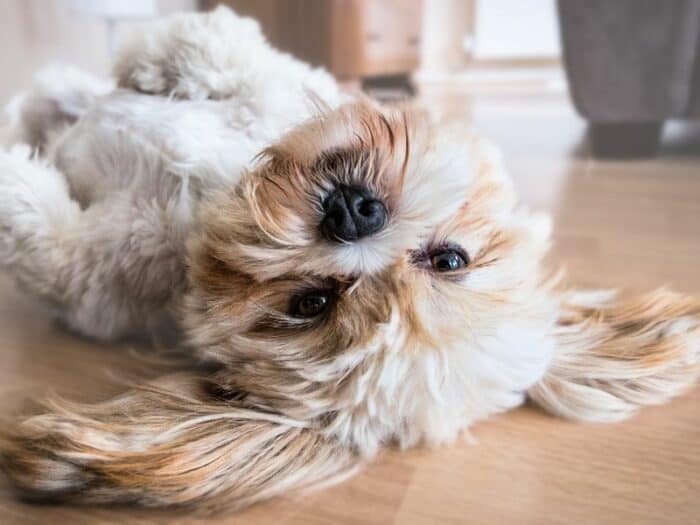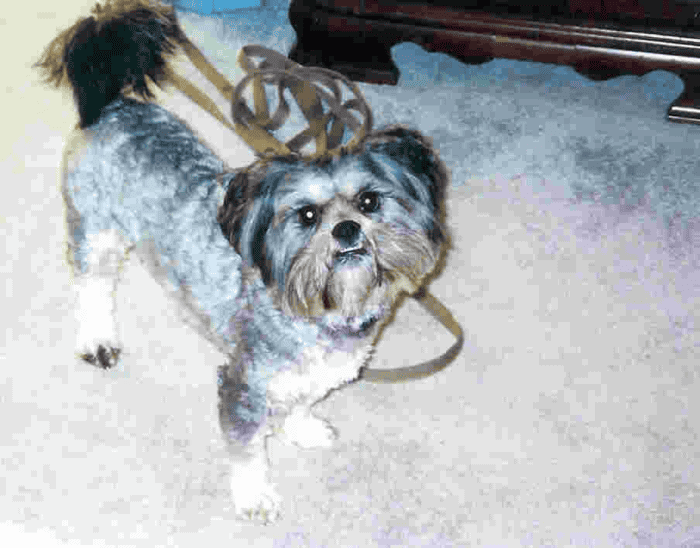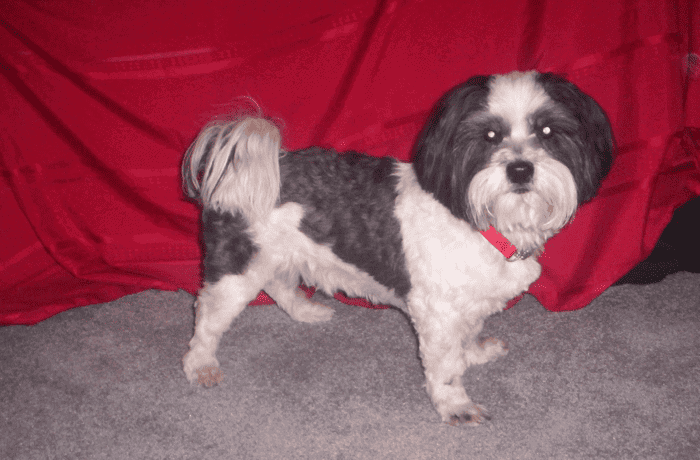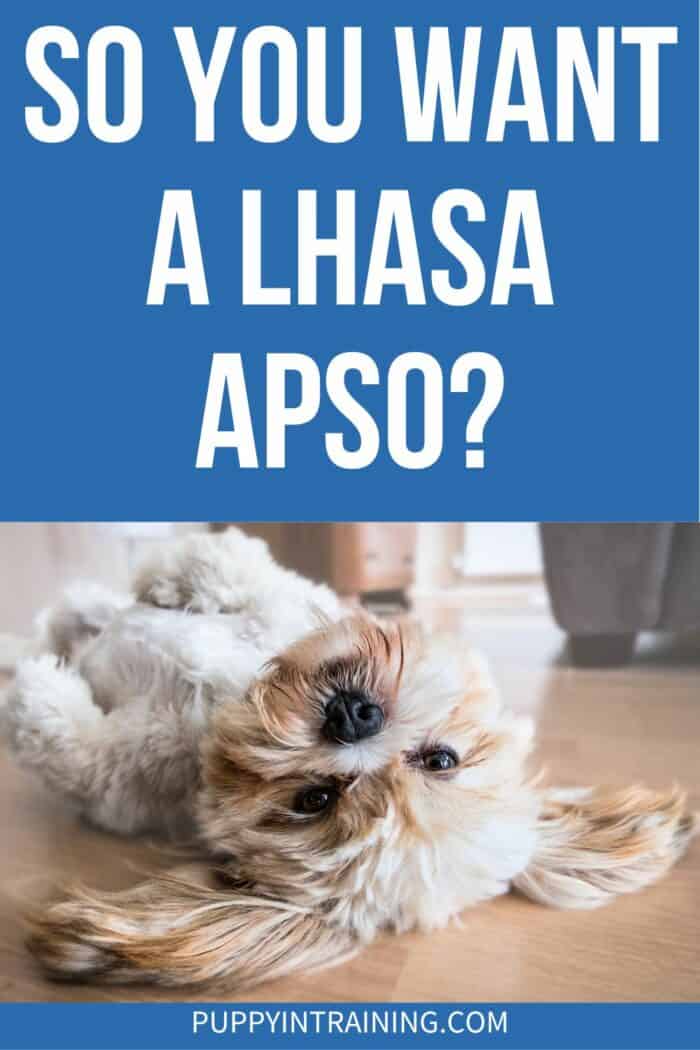So You Want a Lhasa Apso?
This post may contain affiliate links. We may earn money or products from the companies mentioned in this post.
If you’re looking for a small portable dog who can accompany you everywhere, a Lhasa apso may be the right breed for you.
They are fine for novice owners who train and set limits for them.
Lhasa apsos may be adorable, but they aren’t shy, retiring flowers. They are an independent, high-maintenance breed that need a strong leader.

So, if you’re looking for a clever, big dog in a small package, look no further than the Lhasa apso.
Keep reading and I’ll tell you both the positive and negative traits of the breed. Then, you can decide whether it’s a good fit for you.
I’ve had three Lhasa apsos. Two were rescues who came to me with many behavioral issues. Ralphie, my current Lhasa, came from a reputable breeder as a puppy.
They are very independent dogs who need a firm but fair leader. If a Lhasa isn’t trained regarding what’s expected of him, he may easily take over a household.
So You Want A Lhasa Apso?
The good, the bad, and the ugly. 24 facts about the breed.

1. Lhasa Apsos Are in the American Kennel Club (AKC) Nonsporting Group
They are intelligent dogs with big personalities. Strong-willed and feisty, they are independent and wary of strangers.
In 1935, they were originally registered by the AKC as terriers. But, in 1959, they were registered in the Nonsporting group.
2. They Don’t Require a Lot of Physical Exercise But Are Hardy Dogs
Lhasas need a couple of walks and play sessions a day to stay fit. Unlike some small dogs such as shih tzus (who they’re often mistaken for), they are hardy companions not couch potatoes.
They can even accompany you on short hikes as long as they can rest and the temperature isn’t extreme.
And they love to burn off energy running around a fenced yard. So a Lhasa who gets the zoomies will burn off some energy.
If their needs are met, though, they will settle in nicely with you while you binge-watch your favorite Netflix series.
Because of their structure, they don’t make good swimming companions though.
As intelligent companions, they need mental stimulation as well as physical exercise. So provide them with enrichment activities, including puzzle toys.
A bored Lhasa can become destructive.
3. They Have a History as Watch Dogs
Lhasas are tough cookies. For thousands of years, they were bred in monasteries as watch dogs and protectors.
They are named after the holy city in Tibet, Lhasa. There, he’s known as “Abso Seng Kye,” which translates to “Bark Lion Sentinel Dog.”
With their big-dog bark, Lhasas remained inside. They would call the larger, Mastiff-type dogs who were outdoors to protect the territory in temples and monasteries in the Himalayan mountains
Hardy dogs, the Lhasa’s dense double coat protected him from the intense heat and extreme cold in his native Tibet.
They were considered sacred and weren’t permitted to leave the country unless given–in pairs–by the Dalai Lama.
They were so valued that it was believed that when an owner died, his soul entered his Lhasa’s body.
In 1933, the first pair of Lhasa apsos to enter the United States were given by the 13th Dalai Lama to noted explorer and naturalist C. Suydam Cutting.
These became the foundation stock at Hamilton Farm, which Cutting owned in Gladstone, New Jersey.
4. They Require a Lot of Grooming, Which Is Expensive
If you’re looking for a low-maintenance breed, a Lhasa isn’t for you.
They have a dense, double coat that constantly grows and requires daily brushing if kept long.
You can use a pin brush, slicker brush, and greyhound comb. If not properly groomed, a Lhasa can become a matted mess.
You can keep them in a puppy cut, which cuts down on maintenance. Even then, a quick brushing every other day is required.
And professional grooming is expensive if you don’t know how to cut your Lhasa’s hair yourself.
Over the years, I’ve learned how to cut my Lhasas’ hair. Breeders and groomers I know taught me what grooming tools to purchase and techniques to use.
Of course there’s a learning curve in the beginning. And there’s the initial investment in clippers, scissors, brushes, combs, and nail clippers. But it’s paid for itself many times over.
A Lhasa’s beard should be groomed daily to be sure that it’s clean. A bath every two weeks should suffice unless he gets dirty and requires an additional one.
And make sure that the dog’s thoroughly rinsed and brushed because even clean hair can mat.
Regular nail trims every two weeks are required. Lhasas require their pet parents to regularly check and clean their ears to insure they don’t get an infection.
It’s crucial that you get a Lhasa used to handling as a young puppy. And he needs to learn to stand still for grooming.
I teach this to all my dogs. Even the rescues who weren’t accustomed to being groomed learned to enjoy or at least accept the process.
But it took them more time to learn what was required because they came to me after years of not learning to be handled.
And get your dog used to having his teeth brushed with toothpaste made for dogs. Daily brushing can help avoid dental problems.
5. They Aren’t Big Shedders and Are “Hypoallergenic”
Lhasas have hair, not fur, and aren’t big shedders. Of course, you may find a loose hair occasionally.
No dog is 100 percent hypoallergenic. But, if you keep your Lhasa properly groomed, she will come close.
6. They Come in Various Colors
Lhasas come in a wide variety of standard colors:
- Black
- Black and tan
- Tan
- Cream
- Golden
- Grizzle
- Red
- Red gold
- White
They also can come in the nonstandard colors of: blue, charcoal, gray, liver, and silver.
They also can have the following markings: Black mask with tips, black tips, brindle, parti-color, sable, white markings, or sable with white markings.
7. A Lhasa’s Sweet Look Belies a Tough, Independent Temperament

Lhasas shouldn’t be aggressive. But they are tough, independent characters.
They may look like cute stuffed toys, with their long hair parted down the middle, curled tail over the back, and large, dark, oval-shaped eyes.
But make no mistake about it, they are sturdy, robust dogs who will be protective and bark at strangers when necessary.
Lhasa fanciers say that the dogs have “Lhasa-tude.”
They aren’t friendly like goldens or labs. Instead, they take their watchdog heritage seriously and are naturally wary of strangers.
So it’s extremely important to socialize a Lhasa from puppyhood. He needs ongoing, lifetime socialization to new people and friendly dogs so that he doesn’t become overly protective.
It’s crucial that a Lhasa is consistently taught to accept others.
Lhasas don’t see themselves as small dogs. Quite the contrary: it’s said when a Lhasa looks at his reflection in the mirror, he sees a lion.
8. Lhasas Are Great Travel Companions
They are compact dogs who can adapt to many situations.
Get your Lhasa used to traveling when he’s young so that he doesn’t become car sick. Then you can take him with you on your adventures.
Lhasas often bond closely to one or two people in the family. But they should learn to accept everyone in the family and others who you accept.
A Lhasa is playful, charming, and comical with those he trusts. He entertains his human companions with his antics, which can include perching on the back of a sofa to be a sentinel who surveys all in the room.
A well-bred, socialized, and trained Lhasa loves to go on adventures with his pet parent.
He loves to walk or you can train him to go along in a carrier or carriage made for the purpose.
I recommend walking Lhasas in a well-fitted harness rather than a collar to avoid tracheal damage.
9. They Are Small Dogs

- Males stand at 10 to 11 inches at the shoulder, females slightly smaller
- They are between 12 and 18 pounds
10. They Adapt To Living in the City, Country, or Suburbs
Lhasas adapt to their surroundings. But, because they tend to be protective barkers, it’s important to train them to be quiet.
This is where proper training and socialization comes in. A Lhasa needs to be able to discern friend from foe.
And he needs to learn to ignore everyday sounds rather than bark an alert signal to normal noises and everyday interactions.
Then, he should be able to live even in attached housing and apartments.
11. They Are Fine With Respectful Older Children and Friendly Dogs
Of course no dog should be left alone unsupervised with children.
A Lhasa won’t tolerate rough-housing or rough handling and may try to protect himself and bite if he believes that he’s not being treated properly.
So I don’t recommend Lhasas for toddlers, who aren’t able to see the dog as a living creature. Lhasas need to be given their space.
But they can be fine with older children who understand this and respect their boundaries. Lhasas generally prefer the company of adults.
So, if you’re looking for a dog like a golden who will often tolerate and enjoy rough play, a Lhasa isn’t for you.
Lhasas can also be fine with other friendly dogs if properly socialized with them.
But be aware that a Lhasa believes that he IS A BIG DOG. And he is likely to believe that he’s at the top of the pack.
I’ve had as many as six other dogs with my various Lhasas.
A Lhasa will choose which dogs he wants to befriend and generally just wants to ignore–and be ignored by–the others.
12. They Have Long Lives
Lhasas have a life expectancy of 12 to 15 years. Some live to be much older.
My rescued Lhasa Mikey lived to be about 13 years old. And my rescued Lhasa Linkin lived to the ripe old age of about 16 years old.
They age gracefully and maintain a youthful appearance and attitude into their teens.
13. Lhasas Are Prone to Some Health Problems
Make sure to get your Lhasa from a reputable breeder or rescue group. Puppy mill or back-yard breeder dogs are susceptible more than well-bred Lhasas to behavioral and health problems. Although they are generally a hardy breed, they are susceptible to some health problems, including:
- Mild to severe inherited kidney dysfunction
- Dry eye
- Corneal ulcers
- Progressive retinal atrophy (PRA)
- Cataracts
- Glaucoma
- Patellar luxation (slipped stifle)
- Hip dysplasia
- Cherry eye
- Allergies
- Sebaceous adenitis
- Pigmentary keratitis
- Hemorrhagic gastroenteritis (HGE)
- Umbilical and inguinal hernias
- Bladder calculi (stones)
14. They Are Prone To Certain Problems Because of a Short Muzzle
Although a Lhasa’s muzzle isn’t as flat as that of a shih tzu or pekingese, he still has certain issues because it is relatively short.
So get out your ear plugs if you have a Lhasa as they are prone to snoring.
As a short-muzzled breed, they are also prone to a reverse sneeze in which the dog snorts and gags for no more than a minute or two to clear mucus.
Though not harmful, a reverse sneeze is frightening to hear.
Because of his flat muzzle and large eyes, he is also prone to eye injuries.
Working, watchdog Lhasas (as well as those shown in conformation) wear their long hair covering their eyes for protection.
But I keep my Lhasa’s hair short on his head and out of the eyes to avoidant possible irritation from the hair itself.
A Lhasa should not be left outside in the heat, as he can suffer from heat exhaustion.
15. They May Be Difficult To House Train
Lhasas are often difficult to house train. But if you’re consistent, a healthy Lhasa should be able to be trained.
But, with patience and persistence, I haven’t met a healthy Lhasa who couldn’t be reliably house trained.
Also, some pet parents train them to use potty pads for their convenience and in case they need to go to the bathroom when they’re away.
16. Lhasas Need Early and Ongoing Socialization
They were bred to be watchful and protective and to think independently. Because of this, Lhasas have an innate proclivity to be suspicious of new people and situations.
So early and ongoing socialization is crucial or a Lhasa may become overprotective and aggressive. So get your Lhasa used to people, animals, and situations he will face in his life.
Although he won’t become friendly like a Lab, he should learn to discern friend from foe. And to accept other people and friendly dogs.
Be aware that he does have a high prey drive to other animals. So be sure that he’s socialized to cats from puppyhood if he will be living with them.
17. They Require Firm But Fair Training from Puppyhood Throughout Their Lives or Can Take Over a Household
Lhasa apsos are extremely intelligent dogs. But they aren’t biddable like some of the working and herding breeds.
In fact, the American Lhasa Apso Club states in its literature that the Lhasa is not a naturally obedient dog.
Their goal in life isn’t to make you happy. They were bred to be independent watchdogs who make their own decisions.
So use psychology as well as your training skills. Make the training so much fun that the Lhasa believes that it was his idea. By doing so, he will learn more quickly and readily.
If a Lhasa isn’t trained, he can easily take over a household. If you don’t provide and enforce rules, a Lhasa will take it on himself to run a house as he sees fit. And, believe me, you won’t like his “rules,” which will probably include that everything is his.
So teach him obedience cues using a lot of positive reinforcement. Lhasas train well with praise, treats, and play. Training helps set behavior limits and also builds a great bond with your dog.
They don’t do well with repetitive drills. So train in short sessions. Keep the training fun.
So learning new tricks should be a fun learning experience. Dance, beg, roll over, and speak can be great party tricks to show off with a Lhasa.
A Lhasa who isn’t properly bred, trained, and socialized can easily be subject to “small dog syndrome.” He will think that he rules the roost and everyone there is present to serve him.
Also make sure that your Lhasa is taught not to guard places or items–including you.
All three of my Lhasas have learned not only basic cues but also advanced ones, including hand signals. And I’ve taught them not to guard things, people, and areas.
18. Teach a Reliable and an Emergency Recall
All dogs need a reliable recall. But, because of their independent streak, it’s often more work and crucial to teach a Lhasa that coming to you is not negotiable.
My current Lhasa, Ralphie, took longer than other breeds to learn that coming to me was essential–not just a request.
I have to make it “worth his while” to come. This includes praise and special, high-value treats that he receives only when he comes to me.
19. Teach the Dog to Give Up or Leave Items on Cue
Lhasas are prone to resource guarding more than some other breeds are. So teach them a drop or give cue as well as leaving something when told is important to be able to live in harmony with a Lhasa.
My two rescued Lhasas, Mikey and Linkin, came to me as resource guarders. They would guard food. And Linkin also guarded space.
I had to counter-condition and desensitize their natural impulse to guard. It took months but it was worth it to be able to safely live with them.
20. They Are Versatile

Although not the easiest breed to train, Lhasas can succeed in many ventures. They can excel at:
- Agility
- Tricks
- Rally
- Scent work
Lhasas can even successfully compete in competitive obedience, though you won’t see many representatives.
In fact, the first time I showed my Lhasa apso Mikey in AKC Novice class obedience in 2005, the judge exclaimed “Oh, a Lhasa” as I entered the ring.
Mikey always placed in AKC Rally and Obedience–with many first places and a High-in-Trial. And, when he showed, he was a top Obedience and Rally Lhasa.
My Lhasa Ralphie received many first places in two classes of AKC Rally, and even ranked second nationally in the Nonsporting group.
So a Lhasa can do well with patience and consistency.
Personally, I love training them. They are highly intelligent. You just have to be creative and patient when teaching them new behaviors.
21. They Are Expensive
A well-bred Lhasa apso can cost from $1300 up, depending on location and whether the dog is pet or show quality.
22. Lhasas are 86th in Popularity Out of 287 AKC Breeds
Although not one of the most popular breeds, they are popular. So make sure that you get one from a reputable breeder or rescue.
23. Fun Facts
- Lhasa apsos are believed to bring luck and prosperity in pairs, which is why Dalia Lamas often gifted two at a time to the emperors of China
- Many famous people have owned Lhasas, such as Jane Lynch, Ellen Degeneres, Gwen Stefani, Elizabeth Taylor, Kurt Vonnegut, and Liberace
- The Lhasa’s strong, independent personality is often called “Lhasa-tude” by fanciers
24. There Are Valuable Resources To Find a Great Lhasa Apso
- For rescue information, contact Lhasa Happy Homes, Lhasa Apso Rescue, or Lone Star Shih Tzu & Lhasa Apso Rescue
- For breeder referrals, contact the American Lhasa Apso Club or the American Kennel Club
FAQs
I have a shih tzu and am thinking about getting a Lhasa apso. Would it be a good match?
It could be. If you get a well-bred Lhasa puppy from a reputable breeder and properly train and socialize her, they should get along well assuming your shih tzu is also friendly.
You can also get a Lhasa from rescue. Just be sure that he or she is friendly with other dogs, and with your dog in particular.
Good rescues often have their dogs in foster homes and really get to know them. And they train and socialize them too.
Rescues usually have your dog meet the Lhasa you’re thinking of adopting to make sure that it’s a good fit.
Do Lhasas require a lot of grooming? I don’t want to have to pay for professional grooming.
Then a Lhasa is probably not for you. Their hair constantly grows and requires daily grooming.
Even if a Lhasa is kept in a puppy clip, regular grooming is still required–though it will be easier.
Unless you learn how to clip the dog yourself, professional grooming is usually pretty expensive.
My children are two and six years old. Lhasas are so cute. Would one be a good fit?
Probably not. Lhasas can be fine with older, respectful children if properly bred, socialized, and trained.
But a two-year-old won’t realize that a Lhasa is a living creature and may inadvertently injure him.
Lhasas, more than some breeds, are likely to retaliate against harsh treatment and nip or bite.
Final Thoughts
Lhasa apsos can be great companions for the right owner. They are loyal to their pet parents and can be playful clowns.
But they are independent dogs who are generally regally aloof with strangers. And they are high-maintenance and require regular grooming.
Are you thinking about getting a Lhasa apso after reading this blog post?
Do you have Lhasa?
Tell us about it in the comments section below.
Save To Pinterest

Top Picks For Our Puppies
- BEST DOG CHEW
We Like: Beef Collagen Sticks - All of our pups love to bite, nip, and chew. We love using Collagen Sticks to help divert these unwanted behaviors. - BEST PUPPY TOY
We Like: Calmeroos Puppy Toy w/ Heartbeat and Heat Packs - Perfect for new puppies. Helps ease anxiety in their new home. - BEST DOG TREATS
We Like: Crazy Dog Train-Me Treats - We use these as our high-value treats for our guide dog puppies. - BEST FRESH DOG FOOD
We Like: The Farmer's Dog - A couple months ago we started feeding Raven fresh dog food and she loves it! Get 50% off your first order of The Farmer's Dog.
Check out more of our favorites on our New Puppy Checklist.
We had an Lhasa Apso for 16years. Adopted him at 3months old. He was the best easy to train. His name was Cody. He was a family member. Went everywhere with us. Never left him with anyone. He was good with other dogs and children. We miss him very much. Would love to give our loving home to another one. I am home he would never be alone. We own a home with a big yard.Please contact me soon.